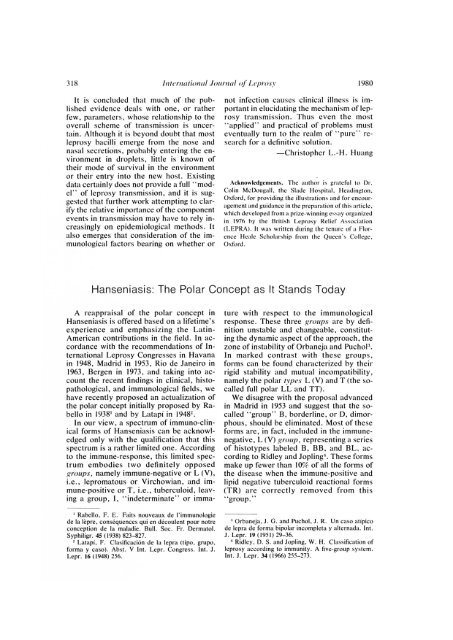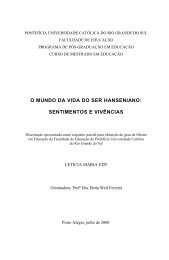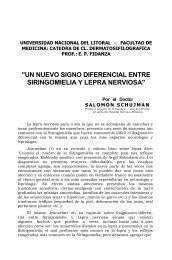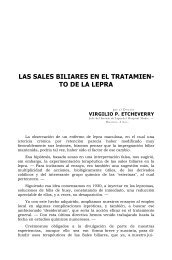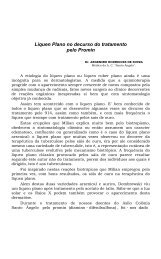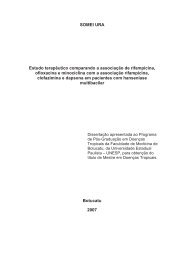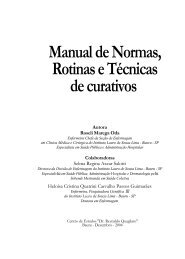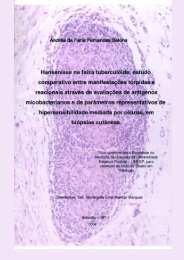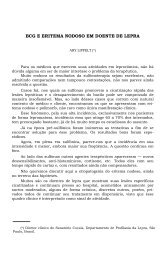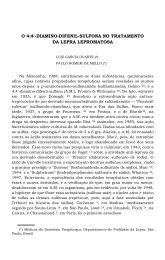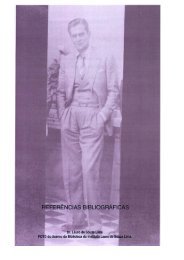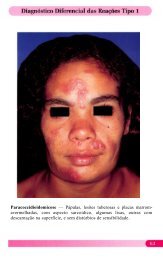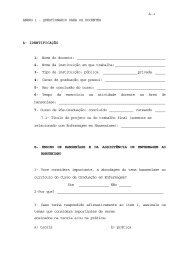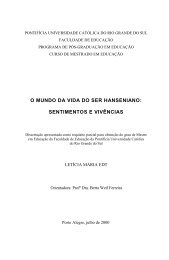EDITORIALS - Index of
EDITORIALS - Index of
EDITORIALS - Index of
You also want an ePaper? Increase the reach of your titles
YUMPU automatically turns print PDFs into web optimized ePapers that Google loves.
318^ htteruatiome/ ./our/i1/ <strong>of</strong> 1.(7)01.Sy^ 1980<br />
It is concluded that much <strong>of</strong> the published<br />
evidence deals with one, or rather<br />
few, parameters, whose relationship to the<br />
overall scheme <strong>of</strong> transmission is uncertain.<br />
Although it is beyond doubt that most<br />
leprosy bacilli emerge from the nose and<br />
nasal secretions, probably entering the environment<br />
in droplets, little is known <strong>of</strong><br />
their mode <strong>of</strong> survival in the environment<br />
or their entry into the new host. Existing<br />
data certainly does not provide a full "model"<br />
<strong>of</strong> leprosy transmission, and it is suggested<br />
that further work attempting to clarify<br />
the relative importance <strong>of</strong> the component<br />
events in transmission may have to rely increasingly<br />
on epidemiological methods. It<br />
also emerges that consideration <strong>of</strong> the immunological<br />
factors bearing on whether or<br />
not infection causes clinical illness is important<br />
in elucidating the mechanism <strong>of</strong> leprosy<br />
transmission. Thus even the most<br />
"applied" and practical <strong>of</strong> problems must<br />
eventually turn to the realm <strong>of</strong> "pure" research<br />
for a definitive solution.<br />
—Christopher L.-H. Huang<br />
Ackninsiedgements. The author is grateful to Dr.<br />
Cohn McDougall, the Slade Hospital, Headington,<br />
Oxford, for providing the illustrations and for encour-<br />
agement and guidance in the preparation <strong>of</strong> this article,<br />
which developed from a prize-winning essay organized<br />
in 1976 by the British Leprosy Relief Association<br />
(LEPRA). It was written during the tenure <strong>of</strong> a Flor-<br />
ence Heale Scholarship from the Queen's College,<br />
Oxford.<br />
Hanseniasis: The Polar Concept as It Stands Today<br />
A reappraisal <strong>of</strong> the polar concept in<br />
Hanseniasis is <strong>of</strong>fered based on a lifetime's<br />
experience and emphasizing the Latin-<br />
American contributions in the field. In accordance<br />
with the recommendations <strong>of</strong> International<br />
Leprosy Congresses in Havana<br />
in 1948, Madrid in 1953, Rio de Janeiro in<br />
1963, Bergen in 1973, and taking into account<br />
the recent findings in clinical, histopathological,<br />
and immunological fields, we<br />
have recently proposed an actualization <strong>of</strong><br />
the polar concept initially proposed by Rahello<br />
in 1938' and by Latapi in 1948 2 .<br />
In our view, a spectrum <strong>of</strong> immuno-clinical<br />
forms <strong>of</strong> Hanseniasis can be acknowledged<br />
only with the qualification that this<br />
spectrum is a rather limited one. According<br />
to the immune-response, this limited spectrum<br />
embodies two definitely opposed<br />
,c,,roups, namely immune-negative or L (V),<br />
i.e., lepromatous or Virchowian, and immune-positive<br />
or T, i.e., tuberculoid, leaving<br />
a group, I, "indeterminate" or imma-<br />
I Rabello, F. E. Faits nouveaux de I . immunologie<br />
de Ia lepre, consequences qui en decoulent pour noire<br />
conception de la maladie. Bull. Soc. Fr. Dermatol.<br />
Syphiligr. 45 (1938) 823-827.<br />
Latapi, F. Clasificacitin de Ia lepra (tipo, grupo,<br />
forma y caso). Abst. V Int. Lepr. Congress. Int. J.<br />
Lepr. 16 (1948) 256.<br />
ture with respect to the immunological<br />
response. These three groups are by definition<br />
unstable and changeable, constituting<br />
the dynamic aspect <strong>of</strong> the approach, the<br />
zone <strong>of</strong> instability <strong>of</strong> Orbaneja and Puchola.<br />
In marked contrast with these groups,<br />
forms can be found characterized by their<br />
rigid stability and mutual incompatibility,<br />
namely the polar types L (V) and T (the socalled<br />
full polar LL and TT).<br />
We disagree with the proposal advanced<br />
in Madrid in 1953 and suggest that the socalled<br />
"group" B, borderline, or D, dimorphous,<br />
should be eliminated. Most <strong>of</strong> these<br />
forms are, in fact, included in the immunenegative,<br />
L (V) group, representing a series<br />
<strong>of</strong> histotypes labeled B, BB, and BL, according<br />
to Ridley and Jopling'. These forms<br />
make up fewer than lt)(i <strong>of</strong> all the forms <strong>of</strong><br />
the disease when the immune-positive and<br />
lipid negative tuberculoid reactional forms<br />
(TR) are correctly removed from this<br />
"group."<br />
Orbaneja, J. G. and Puchol, J. R. Un caso atipico<br />
de lepra de forma bipolar incompleta y alternada. Int.<br />
J. Lepr. 19 (1951) 29-36.<br />
Ridley, D. S. and Jopling, W. H. Classification <strong>of</strong><br />
leprosy according to immunity. A five-group system.<br />
Int. J. Lepr. 34 (1966) 255-273.


